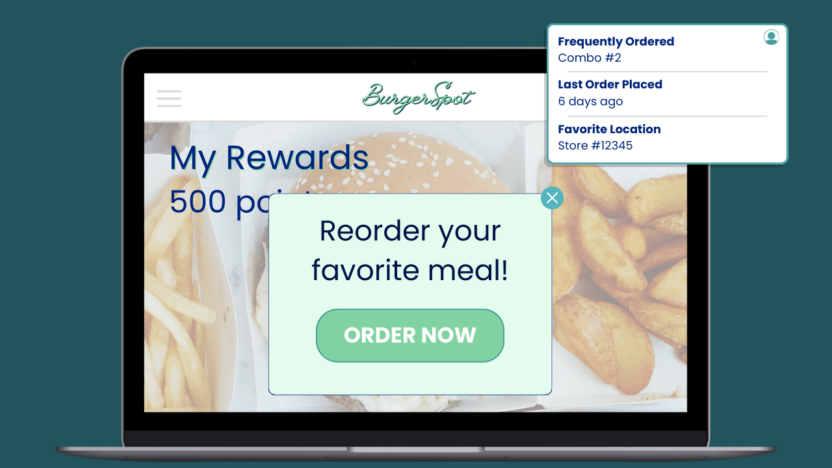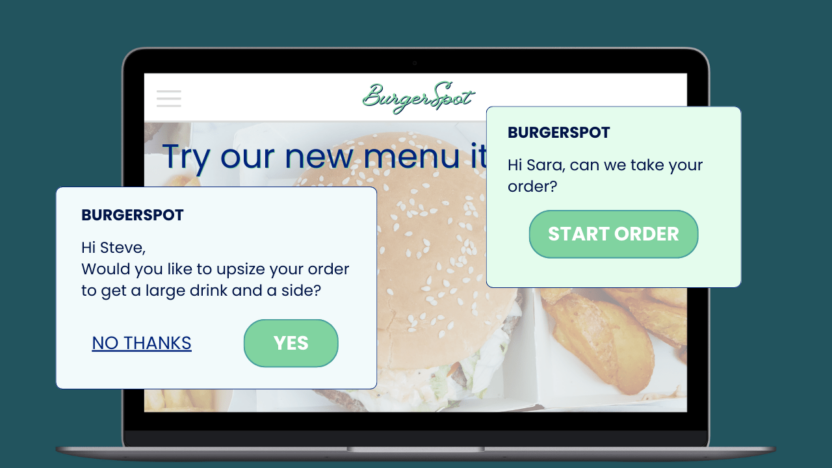Top 5 QSR Marketing Automations for Driving Customer Engagement
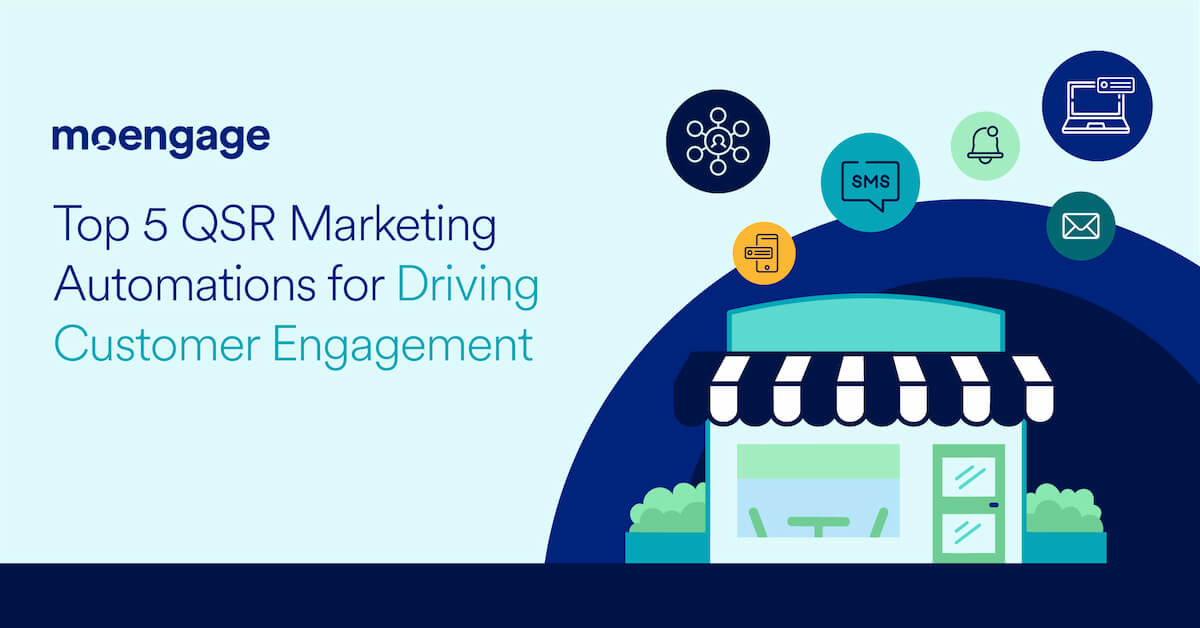
Reading Time: 10 minutes
Consumers who purchase from Quick Service Restaurants (QSRs) don’t just want brands to address them by name, they want personally curated experiences that save them time and make it convenient for them to order meals from any location they want and at any time.
But how can enterprise-level food and beverage companies deliver the depth of personalization needed to drive such engagement at scale?
Marketing automation is a powerful tool that empowers QSRs to provide millions of customers with unique, tailored experiences that create deep, long-lasting relationships. Through the use of marketing automation, QSR marketers can automate routine, repetitive processes, saving them valuable time and resources that can be allocated to other operations.
To help you automate your QSR marketing campaigns (no matter how complex), we cover what QSR marketing automation is, its main benefits, and five different types of automation you can employ to gain traction with your QSR customers.
By the time you’re done reading, you’ll know exactly how you can employ marketing automation to improve conversions, customer engagement, retention, and ROI for your QSR business.
What is QSR Marketing Automation?
Marketing automation refers to the process of using technology to automate repetitive tasks within your marketing operations. For a QSR brand, marketing automation is imperative for reaching customers at scale and delivering quality customer experiences that drive satisfaction and engagement.
QSRs use marketing automation to power their omnichannel marketing strategy that connects with customers at scale while freeing up significant resources.
This spans the entire customer journey, from website personalization and push notifications that grab visitors’ attention, to curated emails and SMS messages that nurture lead-subscription, to in-app messages and mobile push notifications that drive conversions.
10 Benefits of Implementing QSR Marketing Automation
Marketing automation can be applied to various areas of your operations to improve workflows, streamline operations, and maximize productivity.
For the most part, marketing automation provides QSRs with many of the same benefits it provides to businesses in other industries. But some of these benefits have a monumental impact on your bottom line, helping you drive engagement, foster brand loyalty, and sustainably increase revenue.
Here are some of the key benefits:
- Standardizes processes: Automation helps you standardize processes and procedures, reducing any room for human error.
- Saves significant time: Eliminates repetitive, tedious, time-consuming tasks so your team can work more effectively and efficiently.
- Saves money: Minimizes expenses by automating routine processes and streamlining operational workflows.
- Saves human resources: Frees up personnel so they can focus on tasks like strategy-building that drive engagement and conversions.
- Improves productivity: Streamlines and optimizes operations and removes repetitive tasks, to maximize efficiency, effectiveness, and productivity.
- Enhances analytics and powers rich insights: Marketing Automation enables marketers to create self-serve analytics dashboards and provides teams with a wealth of information that powers data-driven decision-making for campaign optimization.
- Increases customer engagement: Automation allows you to implement dynamic A/B testing at scale, helping you identify your best-performing channels and campaigns so you can optimize your strategy and maximize engagement.
- Helps with customer segmentation: Automation allows you to segment customers at scale while understanding individual needs and preferences so that you can engage them with relevant campaigns and communication.
- Enables hyper-personalized experiences: Automate the personalization of customer experiences and marketing campaigns based on real-time insights, allowing you to truly connect with your customers and foster brand loyalty.
- Grows engagement at scale: Automating the execution and optimization of your marketing messaging allows you to engage your customers at scale, whether you’re a small business or an enterprise-level QSR chain.
Overall, marketing automation helps QSR brands connect with customers at the right time and on the right channel, allowing you to foster meaningful relationships and engage customers at scale.
| Looking for inspiration to elevate your engagement campaigns? Read an in-depth analysis of 3 QSR brands acing customer engagement. |
Top 5 QSR Marketing Automation Channels to Improve Customer Engagement
Modern marketing strategies are complicated and dynamic, with a wide range of potential channels of communication available. The more channels you incorporate in your omnichannel strategy, the more complex your strategy becomes (and the more challenging it is to execute it soundly).
Fortunately, marketing automation can solve these challenges and give you the flexibility to experiment with different channels and identify what combination of channels works best for your customers.
Below, we look at some of the most valuable and impactful channels to leverage as part of your QSR marketing strategy, as well as how you can leverage automation to drive customer engagement.
1. Email Automation
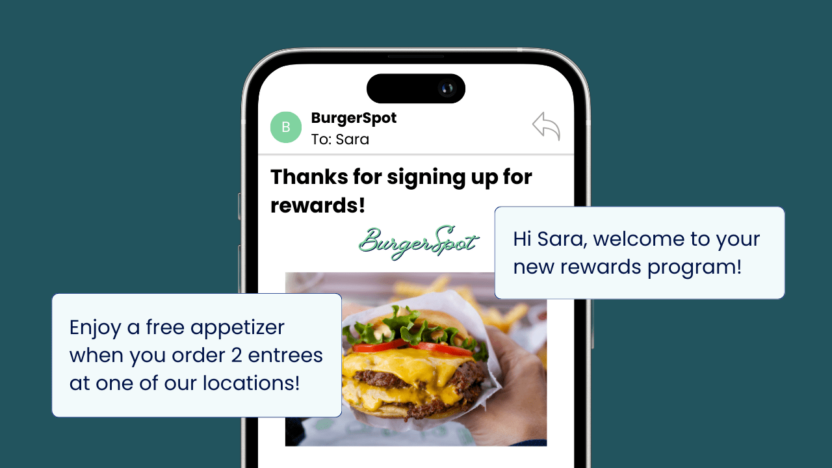
Email is one of the most popularly used channels for marketing and customer engagement. In fact, our recent survey found that 80.9% of food and beverage marketers ranked email as their #1 channel. However, this means you’re battling a wealth of emails while vying for your customer’s attention.
So, how will you break through the noise?
The most critical thing is to ensure you tailor the content, timing, and context of your email marketing materials to get traction with customers. A couple of ways you can do this would be to:
Use email marketing automation to deliver customized, timely offers:
- Send emails with special offers or discounts to engage price-sensitive customers or re-engage hibernating customers. Use geofencing to automatically send promotional emails in real-time that draw customers to an outlet near them. By providing such timely and relevant offers, restaurants can encourage customers to visit more frequently and increase repeat business.
- Use various segmentation strategies to share customized menu recommendations to increase conversions.
- Send emails based on customer preferences, past orders, behavior, on their birthdays, anniversaries, or other special occasions. By offering exclusive discounts or freebies, restaurants can make customers feel valued and encourage them to celebrate at their establishment.
Manage and promote loyalty programs: Restaurants can send automated emails to customers to inform them about their loyalty points, rewards, and exclusive offers. This helps in building customer loyalty and encourages repeat visits.
| 🔵 MoEngage taps into behavioral data and more to help you create email marketing campaigns that resonate with customers on a personal level, fostering engagement and repeat business. |
2. Website Automation
QSR businesses should use onsite messaging and web push notifications to funnel customers towards a conversion event—whether that’s a newsletter subscription, a rewards opt-in, or a purchase.
|
|
|
Website automation allows QSR marketers to do this at scale by helping them:
- Meet customers where they are with customized onsite messaging and web push notifications.
- Craft memorable, sticky web experiences with contextually relevant and individually personalized on-site messaging.
- Curate dynamic web experiences with messaging that automatically triggers based on customer activity.
- Build automated workflows that optimize the content and timing of these messages to enhance lead-capture and conversions.
- Guide visitors along the right pathway by creating shortcuts that make it easier for customers to navigate to what they truly want with intuitively designed pages that serve dynamic content and web push notifications.
When leveraged effectively, onsite messaging and web push notifications can help your business thrive by empowering meaningful customer engagement. They also lead to:
Increased Click-through Rates: Customized onsite messaging provides relevant content and product recommendations and puts that information at the forefront of the customer journey, increasing visibility and engagement. Web push notifications can be short, attention-grabbing, and include compelling calls-to-action. When expertly crafted, both onsite messaging and push notifications can entice customers to click through and engage with the restaurant’s content, promotions, or offers.
Revenue Generation: Onsite orchestration ensures customers receive a curated web experience that encourages engagement and drives conversions. By leveraging web push notifications, restaurants can send targeted and timely messages to their subscribers and customers. These notifications can include personalized offers, discounts, limited-time promotions, or exclusive deals. When visitors receive these notifications, they are more likely to make a purchase or increase their basket size, leading to increased revenue for the restaurant.
| 🔵 MoEngage helps you set up automated on-site messages that get triggered according to individual customers’ preferences and behavior. It also leverages customer segmentation data to help you deliver hyper-personalized website push notifications that understand — and meet — customer demands. |
3. In-App Messaging Automation
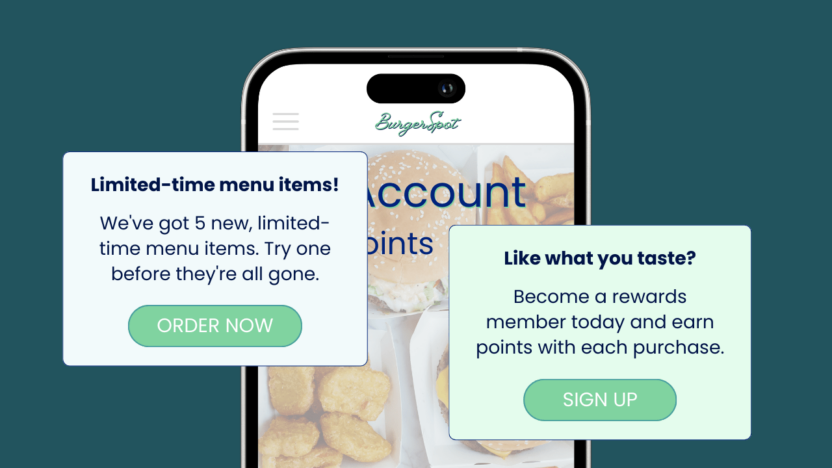
In-app messaging is all about keeping communication centralized and streamlined, so customers stay in your app for a longer time, thus increasing their likelihood of making an order. When leveraged effectively, in-app messaging supports the customer through the buying process, guiding them closer to a purchase.
In-app messaging is also an ideal way of promoting other channels to customers, like email, SMS, and mobile push notifications, providing them with additional touchpoints to interact with your brand.
Furthermore, in-app messaging is relevant for cases where the customer is already browsing through your app or for messages they don’t need to see until the next time they open the app. This keeps such messages unified and ensures the customer sees them at the optimal time, without interrupting their buyer journey.
| In-App Messaging vs Mobile Push Notifications
While in-app messaging and mobile push notifications are done on mobile devices, they are distinctly different modes of communication. Mobile push notifications are alerts that marketers send through a customer’s mobile device, without that customer interacting with the mobile app. Alternatively, in-app messaging refers to communications sent to the customer, within the app. |
This is increasingly important in the realm of QSR, as more businesses leverage apps that allow customers to order, track their order, collect and spend their rewards, and generally manage their account (and relationship with your brand).
When leveraged effectively, in-app messaging increases engagement and conversions by enabling QSRs to:
Stay connected with customers: In-app messaging ensures you’re in constant communication with your customers throughout the buying journey, from welcome messages and onboarding guidance to post-order feedback collection. This empowers you to stay in constant contact with your customers and improve their buying experience.
Send personalized recommendations: As with email and other channels, in-app messaging can be used to provide personalized recommendations to customers based on their preferences, past orders, and behavior. Restaurants can send targeted messages suggesting new menu items, promotions, or special offers that are relevant to each customer’s preferences, and at a time they are mostly likely to make an order.
Communicate feature updates and key company announcements: Promote new product features and communicate major company announcements with customers by using in-app messaging. This ensures customers have access to the most recent update/information when they are ready to make a purchase on the app.
To implement in-app messaging, QSRs can integrate their mobile apps with the in-app messaging automation capabilities of a customer engagement platform and enhance the customer experience to drive conversions.
| 🔵 MoEngage helps with automating in-app messaging that drives referrals and organic growth. By delivering in-app messages that support customers along their journeys, you can funnel more customers to a completed sale while building a lasting relationship along the way. |
4. Mobile Push Automation
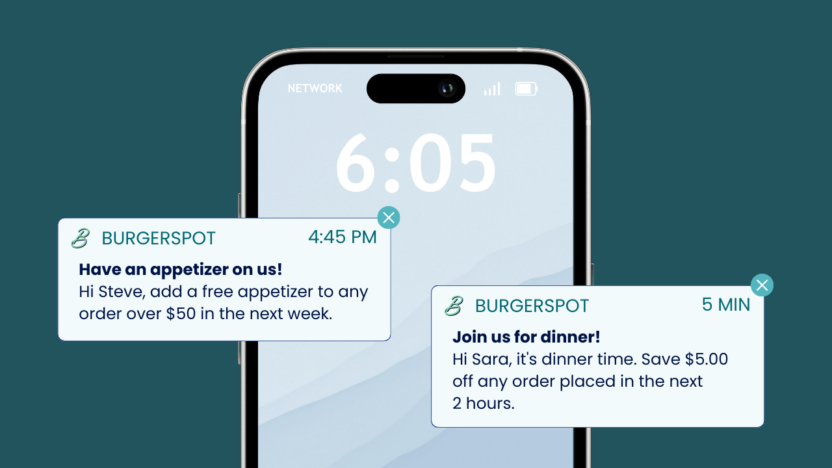
Mobile push notifications are ideal for messages that you don’t want to go unnoticed. They are also an ideal choice when you’re trying to bring the customer directly to your app or to complete a pending action, as these notifications are event-triggered and can have embedded links.
They’re also great for time-sensitive offers that the customer will need to act on quickly and are typically a good choice when you’re looking to motivate a customer to take immediate action or reactivate a dormant customer.
QSR businesses are best served by using mobile push notifications for messages that are designed to get the customer to take a specific action within the app, such as updating their profile, taking advantage of an offer, or placing an order. Here are some common use cases:
Order updates and real-time notifications: In-app messaging enables restaurants to send order updates and notifications directly to the customers’ devices. Customers can receive real-time updates on their order status, estimated delivery or pickup time, and any changes or delays. This keeps customers informed and reduces anxiety, leading to a smoother and more positive experience.
Get nearby customers in-store: Use geofencing to trigger mobile push notifications for nearby (and potentially hungry) customers, encouraging them to visit the closest location. Automating these messages empowers your team to optimize engagement at scale while activating local customers to visit your restaurant.
Engage customers throughout their lifecycle: Event-triggered push notifications enable teams to automate the content and timing of communication to meet the exact needs of a customer, no matter where (or when) they are in the customer lifecycle. Remind customers to finish their profile setup, take advantage of a limited-time offer, or revisit items they’ve left in their cart.
| 🔵 MoEngage helps you employ mobile push notifications that automatically trigger based on the customer’s activity, behavior, and location, helping you send the right message at the right time based on where the customer is in the buying process. |
5. SMS Automation
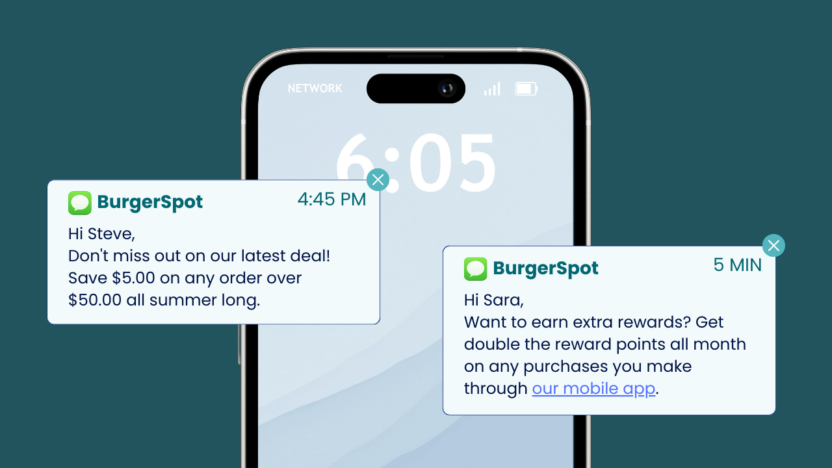
SMS messages certainly have unique and intriguing marketing opportunities, as they have high open and click-through rates.
Based on our recent survey, SMS wasn’t in the top five most popular channels for the Food and Beverage industry. However, that doesn’t mean it can’t be utilized effectively by brands in this space for customer engagement.
To explore how to use SMS for your QSR brand, here are a few pointers:
- It’s best to use SMS marketing when you want to make sure your message is seen, and in cases where the request needs a prompt response.
- Leverage previous browsing and shopping history to provide contextually relevant information and links that nurture leads toward a purchase.
- Automate both the content and timing of these messages for maximum impact and engagement.
- Use rich media message templates featuring images, videos, or GIFs to send eye-catching messages that are unique to your brand.
- Leverage two-way messaging in a conscious way that improves the customer experience, such as confirming an order with “Y” or canceling with “N”, making it easier for customers to interact with your business or even opt-out from receiving further messages
- Send transactional alerts and messages to provide real-time payment, order, delivery, and query updates that improve the customer experience and keep customers engaged throughout the buying process.
| 🔵 MoEngage’s hyper-personalized SMS feature helps you craft and deliver contextually-relevant and eye-catching messages when your customers are most likely to read and engage with them, keeping customers happy and increasing click-through rates and conversions. |
Maximize Engagement and Growth for Your QSR Brand with MoEngage
Marketing automation empowers QSR companies to integrate, streamline, and unify all their channels into a cohesive, effective omnichannel strategy. This customer-centric approach allows marketers to connect with customers on their terms, maximizing customer engagement in the process.
That said, a marketing automation tool is invaluable for QSR brands that want to manage all of their channels from a single tool, powering their omnichannel campaigns and allowing them to automate the entire customer engagement process.
MoEngage’s enterprise-ready, omnichannel Customer Engagement platform empowers teams to automate their marketing program, from workflows to individual campaigns. Using MoEngage, you can create automated workflows in minutes (not days), deploy Smart Triggers that prompt marketing and transactional alerts at the optimal time to 4X your conversions and leverage granular segmentation to curate experiences that resonate with your customers.
MoEngage helps you deploy all of these channels as part of a cohesive, omnichannel strategy, as well as automate the execution of your omnichannel campaigns.
Schedule a demo today to learn how MoEngage’s QSR automation capabilities can 4X your conversions.










